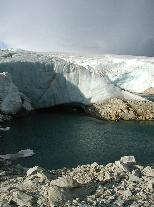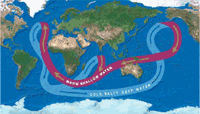 |
|
LAMONT-DOHERTY EARTH OBSERVATORY THE EARTH INSTITUTE AT COLUMBIA UNIVERSITY |
||
| Abrupt Climate Change | ||
| LDEO | ||
| Home | ||
| Divisions | ||
| LDEO Search | ||
| Abrupt CC | ||
| Home | ||
| Q&A | ||
| Contacts | ||
| Research | ||
| Links |
|
back to Q&A 5: How can the paleoclimatological record be used to assess the potential for future abrupt climate change? The value of paleoclimate data is twofold:
There is no reason to expect that, given the extraordinary quantity of greenhouse gases we are putting into the atmosphere, climate cycles of the past 900,000 years will nicely repeat themselves. In other words, paleoclimate data are of no use for forecasting the future in a statistical sense. Nonetheless, they carry a crucial message: the Earth's climate is susceptible to very rapid and large swings in response to rather modest forcings, or without much external forcing at all (i.e. it can act on its own). The Earth climate is an "angry beast". It is best not to poke it inconsiderately.
Forecasting climate change requires the use of sophisticated climate models (General Circulation Models, or GCMs). These are computer programs of tremendous complexity, with many bells and whistles. As a result, slightly different physical assumptions, slightly different computational techniques, or even the same code on different computers, will give rather different answers. That is one reason why the predictions of the Intergovernmental Panel on Climate Change (IPCC, 2001) are so scattered. We can only gain confidence in the physical validity of our models, hence in our predictions of future climate change, by confronting them with stringent tests provided by the paleoclimate record. It is critical that models focus on this task, and that more data be collected to test them. |
|
|

NGDC |
Modeling Observations Paleoclimate |

NAS Report on Abrupt Climate Change |

LDEO CORC/ARCHES Project |

The trigger for the Younger Dryas |

Cultural responses to climate change |

Solar influence on climate change |
LDEO home | search | webmaster | site map | terms-of-use | support LDEO
Copyright © 2003 by The Trustees of Columbia University in the City of New York, Lamont-Doherty Earth Observatory.
All rights reserved.